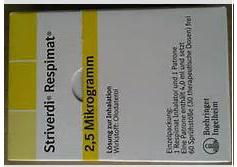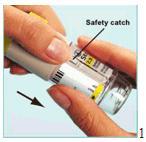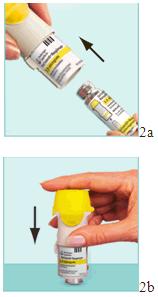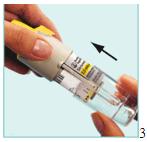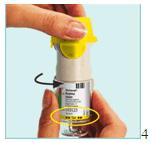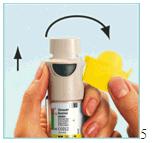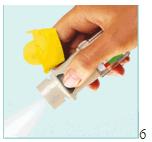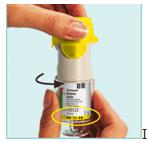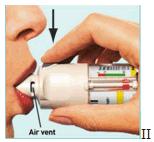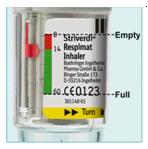|
2013年10月22日,COPD新药Striverdi®Respimat®吸入性喷雾剂,作为一种长期的、每日一次的维持性支气管扩张药物
Daily use of your Striverdi Respimat inhaler
Occurrence of rash may be considered a hypersensitivity reaction with Striverdi Respimat; as with all topical absorbed medication, other hypersensitivity reactions may develop. d. Beta2- agonist adverse reaction profile Striverdi Respimat is a member of the therapeutic class of long-acting beta2-adrenergic agonists. Therefore, the occurrence of undesirable effects related to the beta-adrenergic agonist class should be taken into consideration, such as tachycardia, arrhythmia, palpitations, myocardial ischaemia, angina pectoris, hypertension or hypotension, tremor, headache, nervousness, insomnia, dizziness, dry mouth, nausea, muscle spasms, fatigue, malaise, hypokalemia, hyperglycemia, and metabolic acidosis. Reporting of suspected adverse reactions Reporting suspected adverse reactions after authorisation of the medicinal product is important. It allows continued monitoring of the benefit/risk balance of the medicinal product. Healthcare professionals are asked to report any suspected adverse reactions via the Yellow Card Scheme at www.mhra.gov.uk/yellowcard. 4.9 Overdose Symptoms An overdose of olodaterol is likely to lead to exaggerated effects typical of beta2-adrenergic agonists, e.g. myocardial ischaemia, hypertension or hypotension, tachycardia, arrhythmias, palpitation, dizziness, nervousness, insomnia, anxiety, headache, tremor, dry mouth, muscle spasms, nausea, fatigue, malaise, hypokalemia, hyperglycemia, and metabolic acidosis. Treatment of overdose Treatment with Striverdi Respimat should be discontinued. Supportive and symptomatic treatment is indicated. Serious cases should be hospitalised. Use of cardioselective beta-blockers may be considered, but only subject to extreme caution since the use of beta-adrenergic blocker medication may provoke bronchospasm. 5. Pharmacological properties 5.1 Pharmacodynamic properties Pharmacotherapeutic group: Drugs for obstructive airway diseases; Selective beta2-adrenoreceptor agonists, ATC code: R03AC19 Mechanism of action Olodaterol has a high affinity and high selectivity to the human beta2-adrenoceptor. In vitro studies have shown that olodaterol has 241-fold greater agonist activity at beta2-adrenoceptors compared to beta1-adrenoceptors and 2299-fold greater agonist activity compared to beta3-adrenoceptors. The compound exerts its pharmacological effects by binding and activation of beta2-adrenoceptors after topical administration by inhalation. Activation of these receptors in the airways results in a stimulation of intracellular adenyl cyclase, an enzyme that mediates the synthesis of cyclic-3',5' adenosine monophosphate (cAMP). Elevated levels of cAMP induce bronchodilation by relaxation of airway smooth muscle cells. Olodaterol has the pre-clinical profile of a long-acting selective beta2-adrenoceptor agonist (LABA) with a fast onset of action and a duration of action of at least 24 hours. Beta-adrenoceptors are divided into three subtypes, beta1-adrenoceptors predominantly expressed on cardiac smooth muscle, beta2-adrenoceptors predominantly expressed on airway smooth muscle and beta3-adrenoceptors predominantly expressed on adipose tissue. Beta2-agonists cause bronchodilation. Although the beta2-adrenoceptor is the predominant adrenergic receptor in the airway smooth muscle it is also present on the surface of a variety of other cells, including lung epithelial and endothelial cells and in the heart. The precise function of beta2-receptors in the heart is not known, but their presence raises the possibility that even highly selective beta2-adrenergic agonists may have cardiac effects. Effects on cardiac electrophysiology The effect of olodaterol on the QT/QTc interval of the ECG was investigated in 24 healthy male and female volunteers in a double-blind, randomised, placebo- and active (moxifloxacin) controlled study. Olodaterol at single doses of 10, 20, 30 and 50 microgram, demonstrated that compared with placebo, the mean changes from baseline in QT interval over 20 minutes to 2 hours after dosing increased dose-dependently from 1.6 (10 microgram olodaterol) to 6.5 ms (50 microgram olodaterol), with the upper limit of the two-sided 90% confidence intervals being less than 10 ms at all dose levels for individually corrected QT (QTcI). The effect of 5 microgram and 10 microgram Striverdi Respimat on heart rate and rhythm was assessed using continuous 24-hour ECG recording (Holter monitoring) in a subset of 772 patients in the 48-week, placebo-controlled Phase 3 trials. There were no dose- or time-related trends or patterns observed for the magnitudes of mean changes in heart rate or premature beats. Shifts from baseline to the end of treatment in premature beats did not indicate meaningful differences between olodaterol 5 microgram, 10 microgram and placebo. Clinical efficacy and safety The Phase III clinical development program for Striverdi Respimat included four pairs of replicate, randomised, double-blind, placebo-controlled trials in 3533 COPD patients (1281 received the 5 microgram dose, 1284 received the 10 microgram dose): (i) two replicate, placebo- and active-controlled, parallel-group, 48-week trials, with formoterol 12 microgram twice daily as active comparator [Trials 1 and 2] (ii) two replicate, placebo-controlled, parallel group, 48-week trials [Trials 3 and 4] (iii) two replicate, placebo- and active-controlled, 6 week cross-over trials, with formoterol 12 microgram twice daily as active comparator [Trials 5 and 6] (iv) two replicate, placebo- and active-controlled, 6 week cross-over trials, with tiotropium HandiHaler 18 microgram once daily as active comparator [Trials 7 and 8]. All studies included lung function measurements (forced expiratory volume in one second, FEV1); the 48 weeks studies evaluated peak (AUC0-3) and trough lung function responses, while the 6 week studies evaluated the lung function profile over a continuous 24 hour dosing interval. The two replicate, placebo- and active-controlled, 48 week trials also included the Transition Dyspnea Index (TDI) as a measure of dyspnea and the St. George's Respiratory Questionnaire (SGRQ)as a measure of health-related quality of life. Patients enrolled into the Phase III program were 40 years of age or older with a clinical diagnosis of COPD, had a smoking history of at least 10 pack years and had moderate to very severe pulmonary impairment (post-bronchodilator FEV1 less than 80% predicted normal (GOLD Stage II-IV); post-bronchodilator FEV1 to FVC ratio of less than 70%). Patient characteristics The majority of the 3104 patients recruited in the global, 48-week trials [Trials 1 and 2, Trials 3 and 4] were male (77%), white (66%) or Asian (32%), with a mean age of 64 years. Mean post-bronchodilator FEV1 was 1.38 L (GOLD II [50%], GOLD III [40%], GOLD IV [10%]). Mean β2-agonist responsiveness was 15% of baseline (0.160 L). With the exception of other long acting β2-agonists, all pulmonary medications were allowed as concomitant therapy (e.g. tiotropium [24%], ipratropium [25%], inhaled steroids [45%], xanthines [16%]); patient enrolment was stratified by tiotropium use. In all four trials, the primary lung function efficacy endpoints were change from pre-treatment baseline in FEV1 AUC0-3 and change from pre-treatment baseline in trough (pre-dose) FEV1 (after 24 weeks in Trials 1 and 2; after 12 weeks in Trials 3 and 4). The 6 week trials [Trials 5 and 6, Trials 7 and 8] were conducted in Europe and North America. In Trials 5 and 6, the majority of the 199 recruited patients were male (53%) and white (93%), with a mean age of 63 years. Mean post-bronchodilator FEV1 was 1.43 L (GOLD II [54%], GOLD III [39%], GOLD IV [7%]). Mean β2-agonist responsiveness was 17% of baseline (0.187 L). With the exception of other long acting β2-agonists, all pulmonary medications were allowed as concomitant therapy (e.g. tiotropium [24%], ipratropium [16%], inhaled steroids [31%], xanthines [0.5%]). In Trials 7 and 8, the majority of the 230 recruited patients were male (69%) and white (99.6%), with a mean age of 62 years. Mean post-bronchodilator FEV1 was 1.55 L (GOLD II [57%], GOLD III [35%], GOLD IV [7%]). Mean β2-agonist responsiveness was 18% of baseline (0.203 L). With the exception of other long acting β2-agonists and anti-cholinergics, all pulmonary medications were allowed as concomitant therapy (e.g. inhaled steroids [49%], xanthines [7%]). Lung function In the 48 week trials, Striverdi Respimat, 5 microgram administered once daily in the morning, provided significant improvement (p<0.0001) in lung function within 5 minutes following the first dose (mean 0.130 L increase in FEV1 compared with a pre-treatment baseline of 1.18 L). Significant improvement in lung function was maintained for 24 hours (mean 0.162 L increase in FEV1 AUC0-3 compared to placebo, p<0.0001; mean 0.071 L increase in 24 hour trough FEV1 compared to placebo, p<0.0001); the lung function improvements were evident in both tiotropium users and non-tiotropium users. The magnitude of the bronchodilating effect of olodaterol (FEV1 AUC0-3 response) was dependent on the degree of reversibility of airflow limitation at baseline (tested by administration of a short-acting beta-agonist bronchodilator); patients with a higher degree of reversibility at baseline generally exhibited a higher bronchodilator response with olodaterol than patients with a lower degree of reversibility at baseline. For both olodaterol and active comparator, the bronchodilatory effect (when measured in L) was lower in patients with more severe COPD. The bronchodilator effects of Striverdi Respimat were maintained throughout the 48 week treatment period. Striverdi Respimat also improved morning and evening PEFR (peak expiratory flow rate) as measured by patient's daily recordings compared to placebo. In the 6 week trials, Striverdi Respimat showed a significantly greater FEV1 response compared to placebo (p<0.0001) over the full 24 hour dosing interval (mean 0.175 L [Trials 5 and 6] and 0.211 L [Trials 7 and 8] increase in FEV1 AUC0-3 compared to placebo, p<0.0001; mean 0.137 L [Trials 5 and 6] and 0.168 L [Trials 7 and 8] increase in FEV1 AUC0-24 compared to placebo, p<0.0001). mean 0.102 L [Trials 5 and 6] and 0.134 L [Trials 7 and 8] increase in 24 hour trough FEV1 compared to placebo, p<0.0001). Improvements in lung function were comparable to twice daily formoterol [Trials 5 and 6; mean 0.205 L increase in FEV1 AUC0-3 compared to placebo; mean 0.108 L increase in 24 hour trough FEV1 compared to placebo (p<0.0001)] and once daily tiotropium HandHaler [Trials 7 and 8; mean 0.211 L increase in FEV1 AUC0-3 compared to placebo; mean 0.129 L increase in 24 hour trough FEV1 compared to placebo (p<0.0001)]. Dyspnea, Health-related Quality of Life, Rescue Medication Use, Patient Global Rating The Transition Dyspnea Index (TDI) and the St. George's Respiratory Questionnaire (SGRQ) were also included in the replicate, placebo- and active-controlled, 48-week trials [Trials 1 and 2]. After 24 weeks, there was no significant difference between Striverdi Respimat, formoterol and placebo in the TDI focal score, due to an unexpected improvement in the placebo group in one study (Table 1); in a post-hoc analysis that accounted for patient discontinuations, the difference between Striverdi Respimat and placebo was significant. Table 1 TDI focal score after 24 weeks of treatment
Table 2 SGRQ total-score after 24 weeks of treatment
In each of the 48 week trials, patients treated with Striverdi Respimat perceived a greater improvement in their respiratory condition compared to placebo, as measured by a Patient´s Global Rating (PGR) scale. Paediatric population The European Medicines Agency has waived the obligation to submit the results of studies with Striverdi Respimat in all subsets of the paediatric population in chronic obstructive pulmonary disease (COPD) (see section 4.2 for information on paediatric use). 5.2 Pharmacokinetic properties a. General Introduction Information on the pharmacokinetics of olodaterol has been obtained from healthy subjects, COPD and asthma patients following oral inhalation of doses at and above the therapeutic dose. Olodaterol showed linear pharmacokinetics with a dose-proportional increase of systemic exposure after single inhaled doses of 5 to 70 microgram and multiple once daily inhaled doses of 2 to 20 microgram. On repeated once daily inhalation steady-state of olodaterol plasma concentrations was achieved after 8 days, and the extent of exposure was increased up to 1.8-fold as compared to a single dose. b. General Characteristics of the Active Substance after Administration of the Medicinal Product Absorption Olodaterol reaches maximum plasma concentrations generally within 10 to 20 minutes following drug inhalation. In healthy volunteers the absolute bioavailability of olodaterol following inhalation was estimated to be approximately 30% whereas the absolute bioavailability was below 1% when given as an oral solution. Thus, the systemic availability of olodaterol after inhalation is mainly determined by lung absorption. Distribution Olodaterol exhibits multi-compartmental disposition kinetics after inhalation as well as after intravenous administration. The volume of distribution is high (1110 L), suggesting extensive distribution into tissue. In vitro binding of [14C] olodaterol to human plasma proteins is independent of concentration and is approximately 60%. Olodaterol is a substrate for the P-gp, OAT1, OAT3 and OCT1 transporter. Olodaterol is not a substrate for the following transporters: BCRP, MRP, OATP2, OATP8, OATP-B, OCT2 and OCT3. Biotransformation Olodaterol is substantially metabolized by direct glucuronidation and by O-demethylation at the methoxy moiety followed by conjugation. Of the six metabolites identified, only the unconjugated demethylation product binds to beta2-receptors. This metabolite however is not detectable in plasma after chronic inhalation of the recommended therapeutic dose or doses of up to 4-fold higher. Olodaterol thus is considered the only compound relevant for pharmacological action. Cytochrome P450 isozymes CYP2C9 and CYP2C8, with negligible contribution of CYP3A4, are involved in the O-demethylation of olodaterol, while uridine diphosphate glycosyl transferase isoforms UGT2B7, UGT1A1, 1A7 and 1A9 were shown to be involved in the formation of olodaterol glucuronides. Elimination Total clearance of olodaterol in healthy volunteers is 872 mL/min, and renal clearance is 173 mL/min. Following intravenous administration of [14C]-labelled olodaterol, 38% of the radioactive dose was recovered in the urine and 53% was recovered in faeces. The amount of unchanged olodaterol recovered in the urine after intravenous administration was 19%. Following oral administration, only 9% of the radioactivity (0.7% unchanged olodaterol) was recovered in urine, while the major portion was recovered in faeces (84%). More than 90% of the dose was excreted within 6 and 5 days following intravenous and oral administration, respectively. Following inhalation, excretion of unchanged olodaterol in urine within the dosing interval in healthy volunteers at steady state accounted for 5-7% of the dose. Olodaterol plasma concentrations after inhalation decline in a multiphasic manner with a terminal half-life of approximately 45 hours. c. Characteristics in Patients A pharmacokinetic meta-analysis was performed utilizing data from 2 controlled clinical trials that included 405 patients with COPD and 296 patients with asthma who received treatment with Striverdi Respimat. The analysis showed that no dose adjustment is necessary based on the effect of age, gender and weight on systemic exposure in COPD patients after inhalation of Striverdi Respimat. Renal Insufficiency There were no clinically relevant increases of systemic exposure in patients with renal impairment. Hepatic Insufficiency There was no evidence for differences in elimination of olodaterol, nor did protein binding differ, between subjects with mild or moderate hepatic impairment and their healthy controls. A study in subjects with severe hepatic impairment was not performed. Race Comparison of pharmacokinetic data within and across studies revealed a trend for higher systemic exposure in Japanese and other Asians than in Caucasians. No safety concerns were identified in clinical studies with Caucasians and Asians of up to one year with Striverdi Respimat at doses up to twice the recommended therapeutic dose. 5.3 Preclinical safety data Effects in non-clinical studies were observed only at exposures considered sufficiently in excess of the maximum human exposure indicating little relevance to clinical use. Studies on genotoxicity and carcinogenic potential revealed no special hazard for humans. Increased incidences were observed of mesovarian leiomyoma in rats and of uterus leiomyoma and leiomyosarcoma in mice. This is considered a class effect which is observed in rodents after long-term exposure to high doses of β2-agonists. Up to now, β2-agonists have not been associated with cancer in humans. In the rat, no teratogenic effects occurred after inhalation of doses up to 1054 microgram/kg/day (approximately 1600 times the maximum recommended human daily inhalation dose (MRHDID) in adults (5 microgram) on a mg/m2 basis). In pregnant NZW rabbits the administered inhalation dose of 2489 microgram/kg/day (exposure multiple versus the MRHDID of >3500 on AUC0-24) of olodaterol exhibited fetal toxicity characteristically resulting from beta-adrenoceptor stimulation; these included patchy ossifications, short/bent bones, partially open eye, cleft palate, cardiovascular abnormalities. No significant effects occurred at an inhalation dose of 974 microgram/kg/day (approximately 1580 times the MRHDID in adults on a mg/m2 basis). 6. Pharmaceutical particulars 6.1 List of excipients Benzalkonium chloride Disodium edetate Water, purified Citric acid (anhydrous) 6.2 Incompatibilities Not applicable. 6.3 Shelf life 3 years In-use shelf life: 3 months 6.4 Special precautions for storage Do not freeze. 6.5 Nature and contents of container Type and material of the container in contact with the medicinal product: Solution filled into a polyethylene/polypropylene cartridge with a polypropylene cap with integrated silicone sealing ring. The cartridge is enclosed within an aluminium cylinder. Each cartridge contains 4 ml solution for inhalation Pack sizes and devices supplied: Single pack: 1 Respimat inhaler and 1 cartridge, providing 60 puffs (30 medicinal doses) Double pack: 2 single packages, each containing 1 Respimat inhaler and 1 cartridge, providing 60 puffs (30 medicinal doses) Triple pack: 3 single packages, each containing 1 Respimat inhaler and 1 cartridge, providing 60 puffs (30 medicinal doses) Eight pack: 8 single packages, each containing 1 Respimat inhaler and one 1 cartridge, providing 60 puffs (30 medicinal doses) Not all pack sizes may be marketed. 6.6 Special precautions for disposal and other handling Any unused medicinal product or waste material should be disposed of in accordance with local requirements. 7. Marketing authorisation holder Boehringer Ingelheim International GmbH Binger Strasse 173 D-55216 Ingelheim am Rhein Germany 8. Marketing authorisation number(s) PL 14598/0093 9. Date of first authorisation/renewal of the authorisation 10/10/2013 10. Date of revision of the text http://dailymed.nlm.nih.gov/dailymed/drugInfo.cfm?setid=5d9a5433-857e-44ea-b3d6-2a400ca0cef5 慢阻肺新药Striverdi® Respimat®获得美国及欧盟国家批准 2014年8月3日,FDA已批准Striverdi Respima(olodaterol)吸入性喷雾剂作为一种长期的、每日一次的维持性支气管扩张药物,用于包括慢性支气管炎和/或肺气肿在内的慢性阻塞性肺病(COPD)患者气流阻塞的长期维持治疗。Striverdi Respima不适用于COPD急性恶化的治疗,也不适用于哮喘(asthma)的治疗。 Striverdi Respimat是一种速效、长效支气管扩张剂,于2013年12月获欧盟首批国家英国、丹麦、冰岛。用于COPD患者的维持治疗。作为一种高度选择性吸入性长效β2-拮抗剂(LABA),olodaterol在首个剂量给药后5分钟内便能够提供显著的支气管扩张作用,并能够持续改善FEV1超过24小时。 Striverdi Respimat的获批,是基于III期临床项目的数据。该项目涉及超过4900例COPD患者。数据表明,与常规护理(包括长效和短效抗胆碱能药物、短效β受体激动剂、吸入性糖皮质激素和黄嘌呤)相比,每日一次的Striverdi® Respimat®能够显著改善患者的生活质量。该项目证实,olodaterol是名副其实的每日一次(a true once-daily)长效β2激动剂药物,能够为COPD患者提供24小时的支气管扩张。 |


